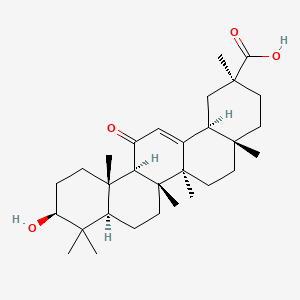| Authors | Title | Published | Journal | PubMed Link |
|---|---|---|---|---|
| Iqbal Choudhary M et al. | Microbial transformation of 18beta-glycyrrhetinic acid by Cunninghamella elegans and Fusarium lini, and lipoxygenase inhibitory activity of transformed products. | 2009 | Nat. Prod. Res. | pmid:19384727 |
| Dey A et al. | Role of connexin 43 in the maintenance of spontaneous activity in the guinea pig prostate gland. | 2010 | Br. J. Pharmacol. | pmid:20735413 |
| Song D et al. | Connexin 43 hemichannel regulates H9c2 cell proliferation by modulating intracellular ATP and [Ca2+]. | 2010 | Acta Biochim. Biophys. Sin. (Shanghai) | pmid:20705586 |
| Sasaki H et al. | 18β-glycyrrhetinic acid inhibits periodontitis via glucocorticoid-independent nuclear factor-κB inactivation in interleukin-10-deficient mice. | 2010 | J. Periodont. Res. | pmid:20682015 |
| Geddawy A et al. | Mechanism underlying endothelium-dependent relaxation by 2-methylthio-ADP in monkey cerebral artery. | 2010 | J. Pharmacol. Sci. | pmid:20838025 |
| Kao TC et al. | Glycyrrhizic acid and 18beta-glycyrrhetinic acid inhibit inflammation via PI3K/Akt/GSK3beta signaling and glucocorticoid receptor activation. | 2010 | J. Agric. Food Chem. | pmid:20681651 |
| Xiao Y et al. | 18Beta-glycyrrhetinic acid ameliorates acute Propionibacterium acnes-induced liver injury through inhibition of macrophage inflammatory protein-1alpha. | 2010 | J. Biol. Chem. | pmid:19897483 |
| Plotnikov EY et al. | Cytoplasm and organelle transfer between mesenchymal multipotent stromal cells and renal tubular cells in co-culture. | 2010 | Exp. Cell Res. | pmid:20599955 |
| Lee CS et al. | 18β-Glycyrrhetinic acid potentiates apoptotic effect of trichostatin A on human epithelial ovarian carcinoma cell lines. | 2010 | Eur. J. Pharmacol. | pmid:20868669 |
| Kapeta S et al. | Nuclear erythroid factor 2-mediated proteasome activation delays senescence in human fibroblasts. | 2010 | J. Biol. Chem. | pmid:20068043 |
18alpha-glycyrrhetinic acid
18alpha-glycyrrhetinic acid is a lipid of Prenol Lipids (PR) class. 18alpha-glycyrrhetinic acid is associated with abnormalities such as Wiskott-Aldrich Syndrome. The involved functions are known as inhibitors, salivary gland development and branching morphogenesis.
Cross Reference
Introduction
To understand associated biological information of 18alpha-glycyrrhetinic acid, we collected biological information of abnormalities, associated pathways, cellular/molecular locations, biological functions, related genes/proteins, lipids and common seen animal/experimental models with organized paragraphs from literatures.
What diseases are associated with 18alpha-glycyrrhetinic acid?
18alpha-glycyrrhetinic acid is suspected in and other diseases in descending order of the highest number of associated sentences.
Related references are mostly published in these journals:
| Disease | Cross reference | Weighted score | Related literature |
|---|
No disease MeSH terms mapped to the current reference collection.
PubChem Associated disorders and diseases
What pathways are associated with 18alpha-glycyrrhetinic acid
There are no associated biomedical information in the current reference collection.
PubChem Biomolecular Interactions and Pathways
Link to PubChem Biomolecular Interactions and PathwaysWhat cellular locations are associated with 18alpha-glycyrrhetinic acid?
There are no associated biomedical information in the current reference collection.
What functions are associated with 18alpha-glycyrrhetinic acid?
Related references are published most in these journals:
| Function | Cross reference | Weighted score | Related literatures |
|---|
What lipids are associated with 18alpha-glycyrrhetinic acid?
There are no associated biomedical information in the current reference collection.
What genes are associated with 18alpha-glycyrrhetinic acid?
There are no associated biomedical information in the current reference collection.
What common seen animal models are associated with 18alpha-glycyrrhetinic acid?
There are no associated biomedical information in the current reference collection.
